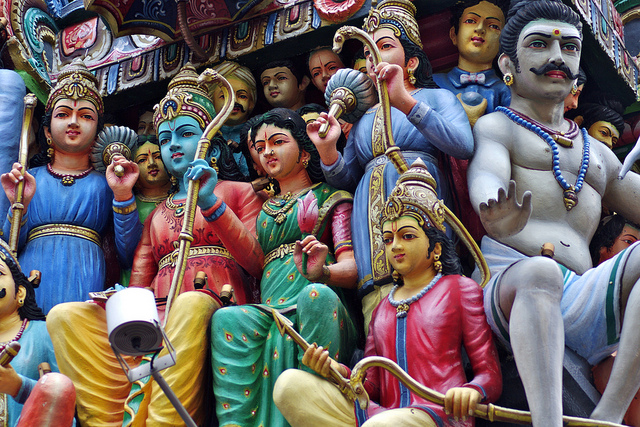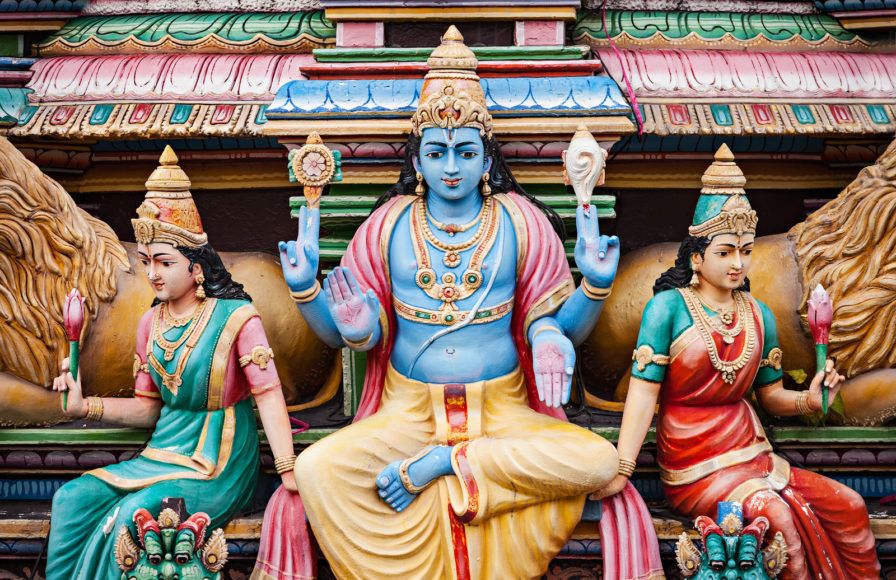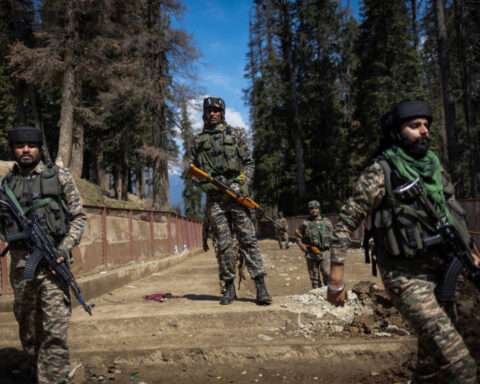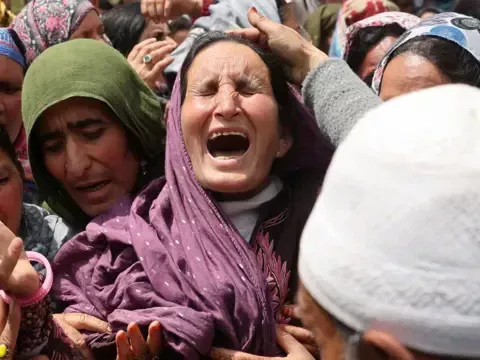Hinduism is a major world religion originating on the Indian subcontinent and widely practiced throughout Southeast Asia. Hinduism is considered dharma, or way of life, and comprises various philosophies, beliefs, and rituals. The four largest denominations of Hinduism are Vaishnavism, Shaivism, Shaktism, and Smartism.
Hinduism, more so than any other religion, accepts and celebrates that truth or reality cannot be encapsulated and must be sought in multiple sources. Many Hindus strongly believe that tolerance is the central religious virtue and considers Hinduism to be a way of life more than a religion.
Prominent themes in Hindu beliefs include the four Puruṣārthas, the proper goals or aims of human life. These are Dharma (ethics/duties), Artha (prosperity/work), Kama (desires/passions), and Moksha (liberation from the cycle of death and rebirth/salvation). Additionally, Hinduism is shaped by five elements: doctrine, practice, society, story, and devotion.
Hinduism is believed to be the oldest religion in the world, developing between 500 BCE and 300 BCE. It is currently the third-largest religion worldwide, with approximately 1.2 billion Hindus in many different countries. Hinduism is the dominant religion in India, Nepal, and Mauritius and has significant populations in the Caribbean, Southeast Asia, North America, South America, and other places worldwide.
The ten countries with the highest Hindu population are:

- India
- Nepal
- Bangladesh
- Indonesia
- Pakistan
- Sri Lanka
- United States
- Malaysia
- United Kingdom
- Mauritius
1. India
India, unsurprisingly, has the largest Hindu population in the world of 1.053 billion, comprising 79.80% of India’s total population. Additionally, about 95% of the world’s Hindus live in India. In addition to Nepal and Mauritius, India is one of three countries where Hindu is the dominant religion. The majority of Hindus in India belong to the Shaivite and Vaishnavite denominations.
2. Nepal
Nepal has the second-highest Hindu population of 23.5 million, which is 81.30% of the country’s population. Hinduism played a large role in Nepal’s history, which was the only Hindu state in the world until 2008. Hinduism in Nepal differs from that in India in three ways: Hinduism and Buddhism are not separated from each other in local populations; there are no influences of Islam, and there are no influences of Bhakti traditions.
3. Bangladesh
Bangladesh has the third-largest population of Hindus at 14.3 million. Hinduism is the second-largest religious affiliation, comprising about 8.7% of the population, while Islam is the largest religion, comprising about 90% of the population. Despite having a relatively large number of Hindus, Bangladesh has seen a steady decrease in the Hindu population since 1940, where the percentage of the total population was 28%.
4. Indonesia
With a Hindu population of 4.4 million, Indonesia has the fourth-highest Hindu community in the world. Indonesia is predominantly Muslim (90%), with only 1.7% of Indonesian people practicing Hinduism. The Bali island in Indonesia has the largest number of Hindus living in Indonesia, with more than 83% of its population being Hindu. A few years after gaining independence from the Dutch, the Indonesian Ministry of Religion came under Islamists’ control, who defined religion as monotheistic. As a result, Indonesia denied rights of citizenship to individuals who did not belong to a monotheistic religion; therefore, the Balinese Hindus adopted their form of Hinduism to be monotheistic. Balinese Hinduism is a distinct type of Hindu worship that incorporates local animism, ancestor worship (Pitru Paksha), and reverence for Buddhist saints (Bodhisattva).
5. Pakistan
Pakistan has about 3.626 million Hindus, comprising 1.85% of its total population. Hinduism is Pakistan’s second-largest religion behind Islam. Hinduism, as well as Buddhism and Sikhism, has been declining in Pakistan for centuries. Non-Muslims in Pakistan have faced discrimination and persecution with the rise of the Muttahida Majilis-i-Amal (MMA), a coalition of Islamist political parties that have taken a specific anti-Hindu stance. Additionally, the rise of the Taliban in Pakistan has further influenced the anti-Hindu attitude and increased persecution of Hindus and all non-Muslims. The religious discrimination and persecution in Pakistan have many Hindus looking to India for safety.
6. Sri Lanka
Hinduism is the oldest religion in Sri Lanka. Sri Lanka has the sixth-largest Hindu population at 2.671 million, comprising about 12.60% of its people. Sri Lankan Hindus are almost exclusively Tamils, the oldest ethnic group in Sri Lanka, with some immigrants from India and Pakistan making up the rest of the Hindu population. Most Sri Lankan Hindus follow the teaching of Saiva Siddhanta while some follow Shaktism.
7. United States
The United States has the seventh-largest Hindu population in the world of 2.23 million, comprising 0.70% of its total population. Most American Hindus are immigrants, and the children of immigrants and about 10% are converts. Hindu-Americans hold the highest educational attainment level among all religious communities in the U.S. Hindu concepts, such as karma, veganism, reincarnation, meditation, yoga, and Ayurveda, have become popular in the U.S. mainstream, believed and practiced by non-Hindus. Hinduism also has the highest retention rate for any religion in the U.S., with 80% of adults who said they were raised as Hindus continuing to adhere to Hinduism.
8. Malaysia
Malaysia has about 1.949 million Hindus, about 6.3% of the country’s total population. Hinduism is the fourth-largest religion in Malaysia. Hinduism arrived in Malaysia when Indians began settling during the ancient and medieval eras, most of which still live in peninsular Malaysia. As in some other countries with large Islam populations, Malaysian Hindus face institutionalized discrimination due to discriminatory laws that blatantly favor Muslims. The Malaysian authorities have destroyed hundreds of Hindu temples, and religious violence against Hindus is common.
9. United Kingdom
The United Kingdom has the ninth-largest Hindu population in the world of 832,000 Hindus. This is about 1.70% of the U.K.’s total population. Hinduism was present in the United Kingdom as early as the 19th century when the British Empire had control over India. Most of India’s Hindu migration to the U.K. happened after World War II and came in massive waves during four main periods afterward. According to the United Kingdom’s Office of National Statistics, British Hindus have the highest economic activity of all ethnic minorities in the U.K., and Hindu men are more likely than the general population to be entrepreneurs.
10. Mauritius
Mauritius has a Hindu population of approximately 600,423, comprising about 48.50% of the total population. Mauritius is one of only three nations and India and Nepal, where Hindus are the majority religious group. The Mauritius constitution prohibits discrimination based on religion, protecting any religion, including Hinduism, from the discrimination and persecution seen in other countries.
India, unsurprisingly, has the largest Hindu population in the world of 1.053 billion. This comprises 79.80% of India’s total population. Nepal has the second-highest Hindu population of 23.5 million, which is 81.30% of the country’s population.






